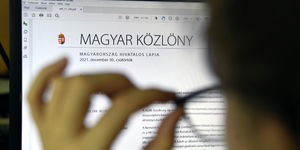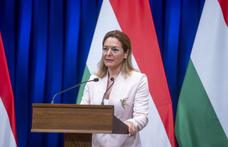But Kazamatak is not about the revolution: this is a drama of the masses, a reconstruction of the times experienced by the crowds gathered in the building and on the square. "We have one house, one square," says the play's narrator, who recalls the French correspondent Jean-Pierre Pedrazzini, who suffered a fatal bullet wound on the square. Peter Gothar, the director, deliberately avoids placing any "holy symbols" in the production: we do not see a Hungarian flag with the hammer and sickle cut out, for example. So those who believe the play neglects the essence of 1956 have misunderstood.
Over the past 15 years, contemporary art has not directly addressed the "Hungarian reality" and the bloodier moments of our past. With Kazamatak, two major writers of the younger generation have set out to do precisely this. There are few precedents: there are no essential works on 1956, least of all on the stage. Thus, the events that Sandor Radnoti recently described as "the paradoxical founding event of our world" have not yet been narrated in the language of art. The generation that experienced those days has proved unable to address
1956 artistically. It may never be able to do so: the best it could do was record what happened as oral history.
It was politics that made an artistic treatment of 1956 impossible, because politics appropriated 1956, colonising it. As a result, there is no point of view, no language in which art could talk about 1956.
Now, however, two writers in their 30s, the prose writer Andras Papp and the poet Janos Terey, have found a way round this. Their perspective is the present, but their language is rooted in Shakespeare's histories, with a bold dash of contemporary Hungarian usage. Their space is the theatre, and they use it as a way of seizing back for art the discourse on 1956.
It has been a while, too, since theatre has been so contemporary: it takes a stand with regard to social issues, building a bridge between the stage and the street. This stylist and reinterpreted tragedy of Republic Square could be the beginning of a new discourse which will allow us to head out to Corvin koz, to Szena ter and the sites of the other sacred battles.
It is likely that the Kazamatak's merciless approach to 1956 will be shocking for many: Hungarians' sense of history seems almost to lack the maturity needed to gaze at events in this way. One thing is certain, however: politics will not be able to exploit this play. The language which the writers give to contemporary rappers, politicians and notorious liars who are still alive will not be welcome for those who seek to appropriate 1956 for themseles.
But things will be crystal clear for the new, successor generation.
There is hope that after the pathos of this anniversary and the commemorations, a play will allow us symbolically to reoccupy that square, giving us the opportunity to seek an artistic approach to 1956.
And while there are as yet no works to reflect the brilliance of Kazmatak, there is now a chance for art and for a receptive audience.
Artists can now try to find a language to discuss historic turning points, and audiences can break free from the diktats of politics, building their own relationship to the past in - as the drama puts it - one thousand nine hundred and fifty six different plays.
Gergely Nagy writes for HVG.hu














